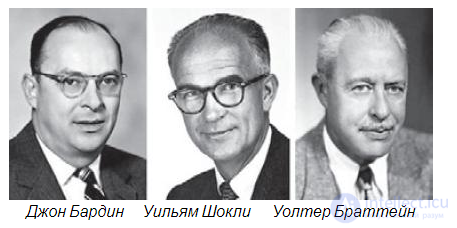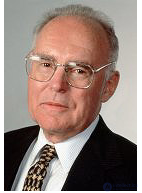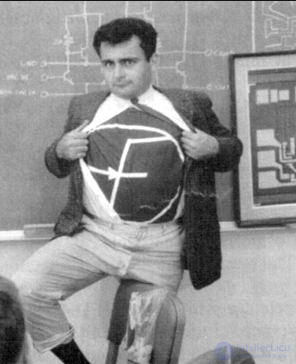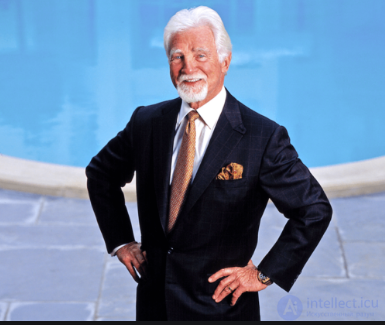Lecture
Fairchild Semiconductor in the field of semiconductor technology has become something like the company Marconi in the field of radio or the firm Xerox in the field of copying documents. But more importantly, the specific discoveries and patents of the people who created this company later became known simply as Fairchildren.

This story is made to begin with William Shockley (William Shockley), the inventor of the transistor. In 1945, at the end of the war, Shockley, who was then working at Bell Labs, became interested in the idea of a semiconductor amplifier, which worked like an electron tube. After the first failures, the idea was picked up by the employees of Shockley by Bell Labs - J. Bardin and W. Brattyn, by whose efforts the first transistor was born in 1948. Later Shokli improved the design, and in 1956 all three were given the Nobel Prize. This fact is remarkable for two reasons: first, it was the first Nobel Prize awarded for technology and not for pure science. It can be argued that exactly this moment symbolizes the end of the era of the domination of academic science and the beginning of the century of industrial scientists. Secondly, co-author Shockley - John Bardeen - remains the only one who received the Nobel Prize in physics twice, and for completely different things: the second in 1972 for explaining the phenomenon of superconductivity (Cooper – Bardeen – Schrieffer theory).

Gordon moore
In 1955, Shockley resigned from Bell Labs and founded Shockley Semiconductor Labs, Shockley Semiconductor Labs, in his hometown of Palo Alto, which is considered the beginning of the creation of the world's largest techno-region, Silicon Valley. This company was then the first and the only one that dealt specifically with semiconductors, and young graduates from various universities were willing to work there. But the relationship did not work out. It is usually said that Shockley was a useless manager. In addition, he relied on germanium structures, and it was already clear that the future belongs to silicon. We should not forget about some of his personal qualities: among other things, Shockley is known as an ideologue of apartheid, he was very seriously engaged in proving the mental inferiority of the black race and put forward various eugenic proposals.
The fact is that in 1957, eight leading engineers left the company Shockley and founded their own company. She became Fairchild Semiconductor. At least the names of two of these eight are now known to the whole world: these were Robert Noyce (Robert Noyce) and Gordon Moore (Gordon Moore).

Robert Widlar
With the birth of Fairchild is associated with one important event. For the money, the G-8 Traitors turned to budding financier Arthur Rock, the only one who found their ideas interesting. Rock found a company that agreed to invest the bulk of the required $ 1.5 million. It was the Fairchild Camera and Instrument Company. From this event, it is customary to count the birth of a new way of financing innovative projects - venture capital (i.e., “risky”) investments. It was Arthur Rock who first used the term "venture capital". By the way, Rock is also the author of the law, which is sometimes called Moore’s second law: the necessary production costs of microchips are doubled every four years.
But back to the semiconductors. At first, the production process in the newborn Fairchild Semiconductor proceeded as follows: silicon and germanium plates were manually loaded into fire-breathing furnaces for doping. Then they were sawn into diamond circles into separate “slices” or “chips” (slice - chip, chip - chip, splinter), to which fine gold wires of leads were soldered by hand under a microscope. Robert Noyce later admitted that he felt sorry for the staff who lost sight in such operations. And in 1959, he put forward the idea of a microcircuit - a chip, where all the compounds are applied to the crystal right in the production process. Later it turned out that a little earlier a similar idea was put forward by Texas Instruments employee Jack Kilby, however, Neuss developed the technology in more detail (this was the so-called planar technology with aluminum interconnects, it is still used today). In addition, although Kilby filed an application earlier (in February 1959) than Neuss (in July of the same year), but the latter had previously received a patent - in April 1961, and Kilby - only in 1964! After a decade of trials, in the end, won, strangely enough, friendship: it was found to consider Neuss and Kilby as the inventors of the chip together - Kilby, as the first to put forward the idea, and Neuss - as the creator of real production technology.

Robert Noyce
In the 60s Fairchild begins to “produce” Fairchildren. In 1963, a department of linear integrated circuits in it was headed by an intern by the name of Robert J. Widlar. He is a pioneer developer of semiconductor operational amplifiers (op amps). They get their name from the fact that they were used to perform operations — addition, multiplication, integration, etc. — over analog signals, in particular in analog computers that were later buried under the pressure of digital technology. But op amps remained an essential component of almost any electronic device associated with analog signals. In traditional circuitry, especially tube, the elements were always saved, and Vidlar was one of the first to realize that for the cost price of a chip, it almost doesn’t matter how many transistors fit on it — ten or a hundred. Therefore, he was able to create OU with characteristics unattainable for discrete circuitry. In 1966, Robert Vidlar retired from Fairchild and transferred to National Semiconductors, a company that later, in the late 80s, was destined to save Fairchild, absorbed by some oil tycoon. In NS, Vidlar has now created a world-famous OU line with names starting with the letters LM. Unfortunately, Vidlar practically did not work since the beginning of the 70s, and in 1991 he died at the age of 53 years. Not only in Russia they drink a lot.
But this is a side, so to speak, line in relation to computer technology. The most famous Fairchildren were, of course, the founding fathers themselves, all the same Neuss and Moore. In 1968, they quit Fairchild, and on July 18 they founded Integrated Electronics. The abbreviated name Intel, by which it is now known to every schoolchild, had to be bought from the owners of the same-name hotel chain for $ 15,000 [2]. Let's not delve into the history of Intel now - this requires at least a separate article. We only note that the same Arthur Rock has become the investor of the new company (by the way, we are partially obliged to him by another brand, Apple).

Jeremy sanders
Almost simultaneously with Intel, Fairchild came out of the depths of another well-known company - AMD. Jeremy Sanders (JeremiahSanders) was educated in the field of electronics (although he dreamed of becoming an artist from childhood.) However, he found his true vocation as a seller. In Fairchild, he appeared in 1961 and quickly became a marketing director. Judging by the stories that tell about this period of his life, Sanders was one of the first to realize an interesting feature of semiconductor production: an increase in sales volumes reduces the cost of chips by tens and hundreds of times, which in turn expands the markets. Indeed, the car, even burst, and cheaper than the materials of which it is made, can not be made. And an electronic chip in itself costs almost nothing - almost all of its cost is made up of money invested in the development and organization of production. So, if you produce millions of chips, then they will cost a penny. And because in order to overtake the competitors, it is possible to set meager prices from the very beginning.

Arthur Rock
Here is one of the stories about Jimmy Sanders. There was such a product in the Fairchild assortment - a 1211 transistor. Its cost was about $ 100, and Sanders sold it to the military for $ 150. Sales volumes, of course, were small, but what a profit! And then the leadership of the Federal Communications Commission decided that all future TV models should contain UHF tuners, for the creation of which the 1211th fit perfectly. However, a component worth $ 100 and even more so $ 150 was not suitable for the mass market. In addition, RCA has created an electronic lamp called Nuvistor. She could do the same job, albeit somewhat worse, but it cost $ 1.05 — more than a hundred times cheaper than the 1211. Neuss and Moore, having estimated the prospects for transferring production from hundreds of pieces for the military to millions for TV manufacturers, gave setting Sanders down to $ 5. The calculation was that when mass production and improvement of technology, the price could be reduced, although at the time of the decision it was still not clear how to do this. But Sanders went even further than the guide recommended, and lowered the price to the same $ 1.05 (at a cost of $ 100 at that time!). The result was not long in coming - between 63 and 65 years old Fairchild won up to 90% of the American market for UHF tuners. The more chips the company made, the cheaper they became, so in the early 70s Fairchild sold this transistor for $ 0.15. Later, Sanders recalled: “We were going to make chips in a factory that we didn’t use, using a technical process that we hadn’t yet developed, but the only thing worth mentioning was that we entered the market with a price of $ 1.05 next week. counting on the future. "
This marketing model has been very successful. And in 1969, after Moore and Neuss, Sanders resigns from Fairchild and begins to look for investors for a new company. Arthur Rock refused him, saying: "All the technology companies on which I was losing money were founded by people from the marketing department." But it is interesting that one of those who invested a certain amount was ... Robert Noyce. You can imagine the situation - after all, Noyce and Moore personally knew all the people involved in this case. However, the main role in this matter was probably played by the fact that the US government (as well as many private giants, for example IBM) never ordered products from monopolists. Therefore, Intel executives simply had to create their own competitors.
A feature of the company, called AMD (Advanced Micro Devices), was, firstly, the lack of technological innovation in the portfolio of the founder. This company was created by the seller, not an engineer. The second feature is best described by the words of Sanders himself: "First, people, and then products with profits will go." AMD is one of the few companies that have a special section on the site - Corporate Culture. Since its inception, the company holds regular festivals with win-win lotteries, collective holidays. Sanders said that after the crisis that followed the terrorist attacks of September 11, AMD became almost the only company that paid off all those who had to be fired.
Until the mid-90s, Advanced Micro Devices did not develop processors, although it did its own research in the field of flash memory (it now owns 13% of this market). In 1995, it also took up microprocessors, and in March 2000, it even furnished its longtime friend, rival Intel, the first to launch a 1 GHz chip on the market. In January 2000, Sanders resigned as CEO of the company he founded. At the time of his departure, he was probably the oldest existing top executive at Fairchildren.
And what about Fairchild itself? In 1996, she was separated from NS and once again turned into an independent and successful one. One of its famous innovations recently became, for example, MOSFET-transistors - crystals, which allowed directly from logic chips to control devices such as electric motors or high-power heaters. With high probability, it can be argued that Fairchild products are necessarily present in any electronic device that you are currently using.
Comments
To leave a comment
History of computer technology and IT technology
Terms: History of computer technology and IT technology